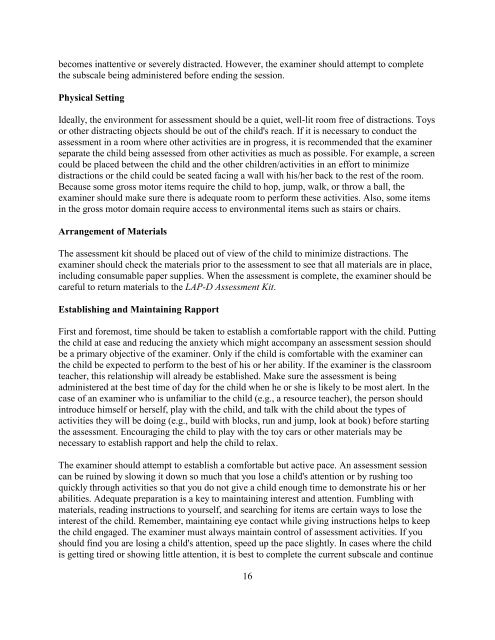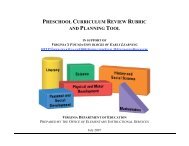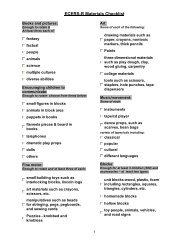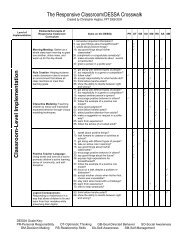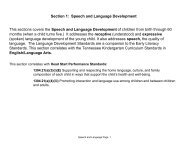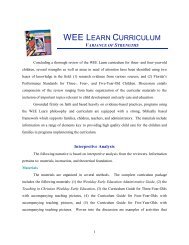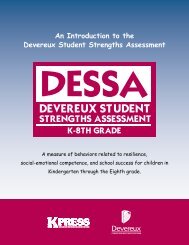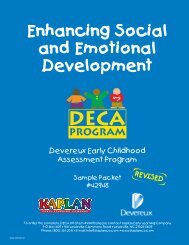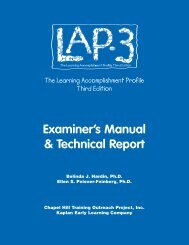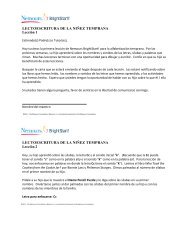e<strong>com</strong>es inattentive or severely distracted. However, the examiner should attempt to <strong>com</strong>pletethe subscale being administered before ending the session.Physical SettingIdeally, the environment for assessment should be a quiet, well-lit room free of distractions. Toysor other distracting objects should be out of the child's reach. If it is necessary to conduct theassessment in a room where other activities are in progress, it is re<strong>com</strong>mended that the examinerseparate the child being assessed from other activities as much as possible. For example, a screencould be placed between the child and the other children/activities in an effort to minimizedistractions or the child could be seated facing a wall with his/her back to the rest of the room.Because some gross motor items require the child to hop, jump, walk, or throw a ball, theexaminer should make sure there is adequate room to perform these activities. Also, some itemsin the gross motor domain require access to environmental items such as stairs or chairs.Arrangement of MaterialsThe assessment kit should be placed out of view of the child to minimize distractions. Theexaminer should check the materials prior to the assessment to see that all materials are in place,including consumable paper supplies. When the assessment is <strong>com</strong>plete, the examiner should becareful to return materials to the LAP-D Assessment Kit.Establishing and Maintaining RapportFirst and foremost, time should be taken to establish a <strong>com</strong>fortable rapport with the child. Puttingthe child at ease and reducing the anxiety which might ac<strong>com</strong>pany an assessment session shouldbe a primary objective of the examiner. Only if the child is <strong>com</strong>fortable with the examiner canthe child be expected to perform to the best of his or her ability. If the examiner is the classroomteacher, this relationship will already be established. Make sure the assessment is beingadministered at the best time of day for the child when he or she is likely to be most alert. In thecase of an examiner who is unfamiliar to the child (e.g., a resource teacher), the person shouldintroduce himself or herself, play with the child, and talk with the child about the types ofactivities they will be doing (e.g., build with blocks, run and jump, look at book) before startingthe assessment. Encouraging the child to play with the toy cars or other materials may benecessary to establish rapport and help the child to relax.The examiner should attempt to establish a <strong>com</strong>fortable but active pace. An assessment sessioncan be ruined by slowing it down so much that you lose a child's attention or by rushing tooquickly through activities so that you do not give a child enough time to demonstrate his or herabilities. Adequate preparation is a key to maintaining interest and attention. Fumbling withmaterials, reading instructions to yourself, and searching for items are certain ways to lose theinterest of the child. Remember, maintaining eye contact while giving instructions helps to keepthe child engaged. The examiner must always maintain control of assessment activities. If youshould find you are losing a child's attention, speed up the pace slightly. In cases where the childis getting tired or showing little attention, it is best to <strong>com</strong>plete the current subscale and continue16
the assessment at a later time. Take caution not to show frustration or displeasure toward thechild but indicate that the assessment will be continued later (e.g., the afternoon, the next day). Achild’s obvious inattentiveness or distraction should be noted in the <strong>com</strong>ment column on theLAP-D Scoring Booklet, or in the notes section when using the LAP-D MSA software on yourPDA.Avoiding CuesThe examiner should be careful not to give cues to the child. Avoid the use of phrases such as,“That's right,” or “Now here's a hard (or easy) one,” or similar phrases. Avoid body languagesuch as nods, frowns, or smiles at the time a child achieves (or fails) a task, which can giveunintended feedback. Phrases such as, "You're working hard!" or "Can you think of anythingelse?" give encouragement, but avoid inappropriate cues. Examiners must be especially carefulto avoid teaching items inadvertently.Following ProceduresThe reliability of assessment with the LAP-D is dependent upon the examiner explicitlyfollowing the instructions in the LAP-D Examiner’s <strong>Manual</strong>. The examiner should read all itemprocedures and criteria prior to administration of an item. The examiner should be careful to saythe verbal instructions exactly as written in the manual. Oral instructions to the child are alwayspreceded by “Say” with the specific verbal instructions in quotations and bold type. Theexaminer should say the verbal instructions clearly, maintain eye contact with the child, andavoid monotonous reading of instructions to young children.Computing Chronological AgeBefore beginning the assessment, the child's chronological age must be calculated to determinethe appropriate starting point for each subscale. Since the starting points on the LAP-D are listedin months, the child’s chronological age must be calculated and converted into months using thefollowing rules.1. Using the left side of the cover page of the Scoring Booklet (called Beginning of Year),write the date of assessment and date of birth in standard form as indicated(month/day/year).2. Use the space to the right of this area to convert dates for <strong>com</strong>putation. To convert boththe date of assessment and date of birth, re-enter the same information in the followingsequence: year, month, day. For example, the date 12/25/2004 is rewritten 2004/12/25.3. To calculate the chronological age in months, subtract the date of birth from the date ofassessment, beginning on the right with the “day” column. Then move to the middlecolumn, “months,” and then the column on the left, “years.”4. If the calculation is not possible without “borrowing,” ALWAYS borrow these amounts:17
- Page 3 and 4: Initial DevelopmentDavid Wilson LeM
- Page 6 and 7: About the AuthorsBelinda J. Hardin
- Page 8 and 9: Interpreting LAP-D Profiles........
- Page 10 and 11: validity, in English and Spanish?
- Page 12 and 13: the LAP-D Third Edition is comprise
- Page 15 and 16: Chapter 2Overview of the LAP-DThis
- Page 17 and 18: egression procedures. This study ex
- Page 19 and 20: Table 1. Subscales of the LAP-DDoma
- Page 21: LAP-D Scoring Booklet. The Scoring
- Page 26 and 27: --When borrowing a month, borrow 30
- Page 28 and 29: Determining Starting PointsOnce the
- Page 30 and 31: Scoring Procedures RulesOnce the st
- Page 32 and 33: Figure 3a. Determining the BasalJOR
- Page 34 and 35: Ceiling RulesThe child’s ceiling
- Page 36 and 37: Additional Scoring Rules1. Administ
- Page 38 and 39: Figure 5. Computing Raw ScoresDEVAG
- Page 40 and 41: complete the Scoring Summary & Prof
- Page 42 and 43: Figure 7: Shanika’s Scoring Summa
- Page 44 and 45: Figure 9: Alan’s Scoring Summary
- Page 46 and 47: Communicating Assessment Results to
- Page 48 and 49: of training and experience required
- Page 50 and 51: sessions, one to three weeks apart,
- Page 52 and 53: Changes were made to the translatio
- Page 54 and 55: 60-65 months 183 62.4 001.8 194 62.
- Page 56 and 57: Table 6. Adults and Number of Child
- Page 58 and 59: Prior to selection of the criterion
- Page 60 and 61: additional 409 children (19.5%; n=2
- Page 62 and 63: means, standard deviations, and cor
- Page 64 and 65: • Comprehension30-35 months 99 08
- Page 66 and 67: Table 12b. Internal Consistency of
- Page 68 and 69: Table 13b. Standard Errors of Measu
- Page 70 and 71: Test-retest reliability was determi
- Page 72 and 73: speaking children, 8.62% were Black
- Page 74 and 75:
Table 17b. Means, Standard Deviatio
- Page 76 and 77:
Table 18b. Zero-order Correlations
- Page 78 and 79:
Table 20. Correlations Between LAP-
- Page 80 and 81:
Table 23 depicts the means, standar
- Page 82 and 83:
Age Equivalent ScoresAn age equival
- Page 85 and 86:
ReferencesAmerican Educational Rese
- Page 87 and 88:
Errata for theExaminer’s Manual &
- Page 89 and 90:
Table A-1. Percentile Rank, NCE, t-
- Page 91 and 92:
Table B-2. Percentile Ranks for LAP
- Page 93 and 94:
Table B-4. Percentile Ranks for LAP
- Page 95 and 96:
Table B-6. Percentile Ranks for LAP
- Page 97 and 98:
Table B-8. Percentile Ranks for LAP
- Page 99 and 100:
Table B-10. Percentile Ranks for LA
- Page 101 and 102:
Table B-12. Percentile Ranks for LA
- Page 103 and 104:
Table B-14. Percentile Ranks for LA
- Page 105 and 106:
30-35 MONTHS 36-41 MONTHS 42-47 MON
- Page 107 and 108:
30-35 MONTHS 36-41 MONTHS 42-47 MON
- Page 109 and 110:
Table C-1. Percentile Ranks for LAP
- Page 111 and 112:
Table C-3. Percentile Ranks for LAP
- Page 113 and 114:
Table C-5. Percentile Ranks for LAP
- Page 115 and 116:
Table C-7. Percentile Ranks for LAP
- Page 117 and 118:
Table C-9. Percentile Ranks for LAP
- Page 119 and 120:
Table C-11. Percentile Ranks for LA
- Page 121 and 122:
Table C-13. Percentile Ranks for LA
- Page 123 and 124:
Table C-15. Percentile Ranks for To
- Page 125:
Table C-16. Spanish Age Equivalents


